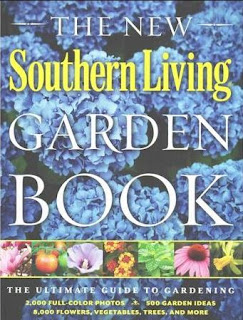Southern History Book of the Month: The New Southern Living Garden Book: The Ultimate Guide to Gardening
The New Southern Living Garden Book: The Ultimate Guide to Gardening
Ed. by Steve Bender
We’re seeing the well-known signs of spring in Alabama: nesting birds, blooming flowers, roadside fruit and vegetable stands . . . well, it’s still early for curb markets, but something about this time of year makes even notorious plant killers like me a little more optimistic about trying to grow something. If warm spring days make you feel like digging in the dirt while visions of fresh produce dance through your head, try The New Southern Living Garden Book.
Edited by Steve Bender, AKA “The Grumpy Gardener,” this book is packed with beautiful color plates and detailed instructions about how to plant and care for practically anything that will grow in a Southern garden. But you might ask, “What makes a garden Southern?” As Bender explains in his introduction to the book, it’s not necessarily what you would expect:
Even if you’re content to leave the gardening to folks with greener thumbs, the Garden Book is entertaining and informative. You’ll recognize plants you’ve seen all your life and never known by name. And since no garden is without its challenges, there’s also a section on common weeds, plant diseases, and the “Sinister Six” of Southern animals that are the bane of gardeners throughout the region. You may want tips on how to keep these creatures out of your yard whether you have a garden or not.
Whether your approach to gardening is decorative or practical, take a look at The New Southern Living Garden Book, which easily accommodates both viewpoints:
For more on gardening in the Southeast:
Southern Living: Garden section
Gardens of the Southeast Region
“13 Beautiful Botanical Gardens Around the South”
“5 Vegetables That Grow Well in the Southeast”
Mary Anne Elllis
Southern History Department
Central Library
Ed. by Steve Bender
We’re seeing the well-known signs of spring in Alabama: nesting birds, blooming flowers, roadside fruit and vegetable stands . . . well, it’s still early for curb markets, but something about this time of year makes even notorious plant killers like me a little more optimistic about trying to grow something. If warm spring days make you feel like digging in the dirt while visions of fresh produce dance through your head, try The New Southern Living Garden Book.
Edited by Steve Bender, AKA “The Grumpy Gardener,” this book is packed with beautiful color plates and detailed instructions about how to plant and care for practically anything that will grow in a Southern garden. But you might ask, “What makes a garden Southern?” As Bender explains in his introduction to the book, it’s not necessarily what you would expect:
Except for blueberries, blackberries, muscadines, elderberries, persimmon, and some nuts, practically nothing we consider a Southern staple is native . . . how, then, can you reconcile a region where people put native and exotic plants on equal footing and eventually consider them both essential parts of our heritage? It has little to do with science. It has a lot to do with style . . . the best Southern gardens express the personalities of their owners. When all is said and done, whether they like it matters more than whether their neighbors do.This book has something to offer at every experience level. You may have ambitions to landscape with plants that guarantee your property will be blooming all year, or you may just want to grow your own vegetables. You might want to attract birds and butterflies to your yard—or stop attracting wildlife by growing plants that deer hate. The Garden Book addresses all of these matters as well as common questions such as which plants grow best in shaded areas or which plants can stand up to drought. There is an explanation of the South’s planting zones and when it’s safe to assume that winter is really over.
Even if you’re content to leave the gardening to folks with greener thumbs, the Garden Book is entertaining and informative. You’ll recognize plants you’ve seen all your life and never known by name. And since no garden is without its challenges, there’s also a section on common weeds, plant diseases, and the “Sinister Six” of Southern animals that are the bane of gardeners throughout the region. You may want tips on how to keep these creatures out of your yard whether you have a garden or not.
Whether your approach to gardening is decorative or practical, take a look at The New Southern Living Garden Book, which easily accommodates both viewpoints:
Thus, we see that the Southern garden has come full circle. We started off growing crops and raising livestock. Now we’ve returned. Granted, most of us will never live on a farm, but that won’t prevent us from implementing the good lessons our forebears taught us. Be good stewards of the land. Share its bounty. Enjoy its beauty.Happy gardening!
For more on gardening in the Southeast:
Southern Living: Garden section
Gardens of the Southeast Region
“13 Beautiful Botanical Gardens Around the South”
“5 Vegetables That Grow Well in the Southeast”
Mary Anne Elllis
Southern History Department
Central Library

Comments